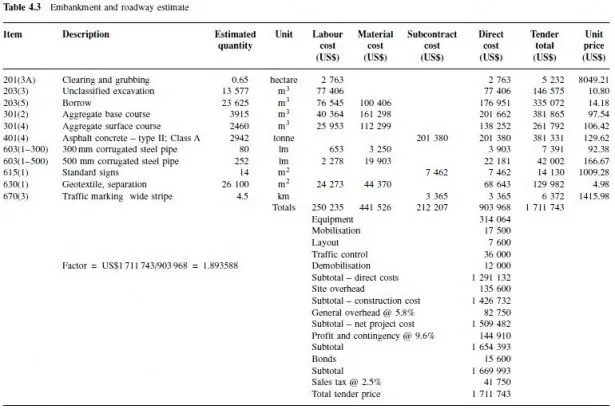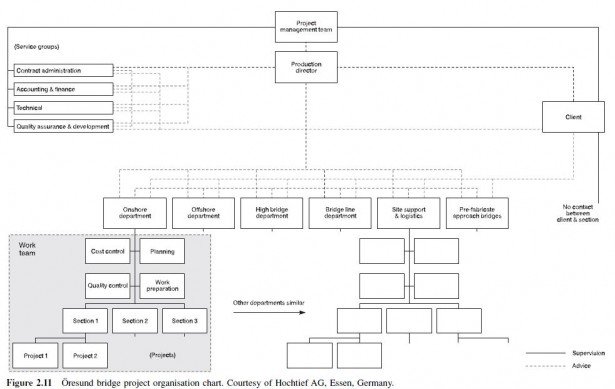Having introduced the broad categories of construction project types, we shall now consider further aspects of the industry by way of some representative statistical data. We want to look at the role that construction plays in the overall economy, the relative proportions of the various construction categories and the character of the industry in terms of the sizes of companies that carry out construction work.
Construction is big business! The industrys significant impact on the world economy can be demonstrated by reviewing constructions proportion of the total value of goods and services, as well as the number of people employed in construction as a proportion of the total workforce and the number of construction firms compared with the total businesses in all industries. Table 1.1 contains representative statistics for several countries. Note that, for the countries listed, the construction industrys contribution to the total value of the economy, measured either as a proportion of value of goods and services or of gross domestic product, ranged between 5.0% and 11.3%. For Australia, for example, the 5.7% for 19971998 represents $30 billion (Australian) out of a total of $522 billion. In that country, construction ranked eighth, after manufacturing (13.2%), property and business services (10.8%), ownership of dwellings (9.7%), finance and insurance (6.4%), transport and storage (6.3%), health and community services (6.2%) and retail trade (5.8%).
The construction workforce comprises between 4.5% and 11.0% of the total workforce for the countries listed in Table 1.1. Using Australia as an example once again, the 7.2% (719 000 workers out of a national workforce of 8 555 000 in 19971998) places construction fifth in contribution to total employment, after retail trade (14.5%), manufacturing (12.8%), property and business services (10.8%) and health and community services (9.6%) (Australian Bureau of Statistics, 1999).

Another measure of an industrys impact on a nations economy is its number of companies, or business units. For the countries listed in Table 1.1, construction firms represented between 8.9% and 13.7% of the countrys firms, in all but one country more than 10%. Italy, for example, reported about 482 000 construction business entities in 1998, out of a total of about 3 905 000 such entities for all industries nationwide. Based on the categorisation in this study, Italian construction had the fourth largest number of firms, after wholesale and retail trade, real estate, renting and business services and manufacturing (Organisation for Economic Cooperation and Development, 2002).
The data that are the basis for the employment and business unit statistics discussed above provide another interesting insight into the nature of the construction industry: the relatively small sizes of construction firms, as measured by their numbers of employees. In the Czech Republic in 1999, for example, the number of employees per construction firm averaged 2.7, while the same statistic for Finland was 3.5 and for the UK, it was 5.3. For every country among the selected sample in Table 1.1, the number of employees per construction firm is significantly lower than the corresponding figure for that countrys manufacturing sector; in the Czech Republic, Finland and the UK, the average number of employees per manufacturing firm can be calculated as 9.2, 14.8 and 23.9, respectively. Although there may be some differences among reporting practices in the various countries, the conclusion is clear: construction work is typically performed by organisations with small numbers of employees.
In Figures 1.1 and 1.2, we show some information about the distribution of construction firm sizes for the New Zealand Construction Industry at one point in 2001 (Statistics New Zealand Te Tari Tatau, 2002). At that time, when the countrys construction firms averaged 3.1 employees, 90.7% of the firms had five or fewer employees, while only 0.3% of the firms had 50 or more employees, as shown in Figure 1.1. An alternate way to analyse these data is shown in Figure 1.2, which shows the proportion of employees in firms of different sizes. Note that the results are more evenly balanced among the four categories, with 47.3% of all construction employees engaged by firms with five or fewer employees and 18.5% employed by firms with 50 or more employees. Similar statistics are available for construction in the USA, where about 80% of construction firms employ fewer than 10 people (US Department of Commerce, 1997).

Recall the earlier description of the various construction industry segments, or sectors, in which we suggested two general categories, general building construction and engineered construction, with subcategories within each. The construction activity for a country or other geographical area can be characterised by the value of work performed in each sector during a certain period. We show one such example in Figure 1.3, in which Irish construction output for 2000 is subdivided into 14 sectors (irishconstruction.com, 2001). This chart shows the major importance of residential construction in this particular country during the time period analysed.


A final interesting characteristic of the construction industry is the large number of specialty trade contractors. Such organisations confine their work to one or two trades, such as electrical work, painting or plumbing and heating. They typically work for general contractors as subcontractors and have no responsibility for the overall project. Figure 1.4 shows the large proportion of specialty trade contractors in US construction in 1997, as compared to general building contractors and engineered construction contractors, while Figure 1.5 indicates that the value of work installed by the three categories was considerably more balanced among the three (US Census Bureau, 2000).



